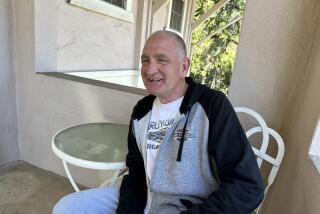NBA : A SPECIAL REPORT : DRUG POLICY: A REPORT CARD : A Year Later, Fears Fade, but Problem Persists
THE GUIDELINES
1 If a player voluntarily comes forth with a drug problem, his team will pay for his rehabilitation program and there will be no loss of salary.
2 If he comes forth a second time, a player will be suspended without pay and will again enter a treatment program.
3 If a player has a third bout with drugs, he will be banned from the league for life, although he can appeal after two seasons.
A year ago, when the National Basketball Assn. and its players’ association implemented a rigid and controversial drug abuse policy, that policy produced feelings of relief, uncertainty and fear.
Relief was evident because the NBA, which reportedly was experiencing widespread use of cocaine and other mind-altering drugs, became the first professional sport to take such strong measures in the battle against drug abuse. But uncertainty and fear also were apparent, since it was a ground-breaking step and the enforcement procedures seemed harsh to many in the NBA.
The guidelines of the policy were clearly stated. If a player voluntarily came forth with a drug problem, his team would pay for his rehabilitation program and there would be no loss of salary. If he came forth a second time, a player would be suspended without pay and would again enter a treatment program. But if a player had a third bout with drugs, he would be banned from the league for life, although he could appeal after two seasons.
In other words, three strikes and you are out.
In addition, a player who did not turn himself in and was caught using drugs, or refused to take a test for drugs, also faced expulsion from the league.
Now, a year afterward, many of the fears have subsided. There has been no mass dismissal of players from the league, no dictator-like enforcement. By the same token, the league has not become drug-free, by any means.
No player has been expelled from the league because of a third offense and only three--John Drew of the Utah Jazz, John Lucas of the Houston Rockets, and Micheal Ray Richardson of the New Jersey Nets-- have reached Strike 2. Richardson, apparently, has been drug-free this season, but Drew and Lucas both tested positive last month and are in treatment centers.
Utah waived Drew, in keeping with a drug clause in his contract, and Lucas retired after his second offense.
According to NBA Commissioner David Stern, a number of players have stepped forward--usually during the off-season--and been admitted to drug treatment centers. Players are given confidentiality to encourage them to seek help. Also, amnesty was granted any player with drug problems before the policy went into effect.
“I believe that the drug policy has been a success--to date,” said Stern when he visited Los Angeles recently. “Whether it will ultimately be a success is something that can only be judged after two or three years. I think it gives the message very strongly that the NBA and drugs don’t mix, but at the same time realizing we aren’t dealing with a simple problem.”
Stern maintains that the drug problem in the NBA, in particular, and sports, in general, merely reflects society’s overall problem. But he admits that there is significant drug use in the NBA. He used the cases of Drew and Lucas, players who had had previous problems with cocaine use but had seemingly overcome them, as examples.
“That’s really tragic,” he said. “They were voluntarily being tested, knew they had so much to lose and, yet, because of their addictions, were not able to resist. That really shows the dimensions of the problem. And anyone who says they have an easy solution should try to deal with it.”
A major criticism of the policy is that the threat of permanent expulsion prevents some players from seeking help. Defending the policy, Stern said he hoped that the fear of the loss of a career would end what is called recreational use of cocaine. “Having a harsh program gives people cause to think about recreational usage,” he said. “That, perhaps, is the first step toward addiction.”
Frank Layden, general manager and coach of the Utah Jazz, says that a crucial shortcoming in the policy is that it covers only cocaine and heroin.
“We limited ourselves by narrowing it to two drugs,” Layden said. “There are 5,000 mind-altering drugs and we pick only the two that are most marketable to a pro athlete’s lifestyle. There are so many others that hurt an athlete. What scares me is that term, ‘recreational use.’ That’s saying certain drugs at certain times are OK.”
When NBA officials and directors of the players’ association met in September, 1983, they knew an immediate solution to a complicated problem couldn’t be found. They also don’t expect the policy they developed to stop drug use, only to curb it.
Said Clipper forward Junior Bridgeman, current president of the players’ association: “I think this was probably one of the few issues (in the collective bargaining agreement) in which both sides wanted something done. The big concern was how to do something fairly. Nobody wanted it to appear punitive, but we all realized the problem was there.
“Our sport has an image to maintain but, beyond that, it’s not good for anyone to be addicted. We realize drug abuse is a sickness, like alcoholism, and we had to deal with it that way.”
Bridgeman says he still thinks the current policy is the best way to approach the problem. But, considering the cases of Drew and Lucas, he believes it could do with some revisions. One thing Bridgeman would like to do is set up treatment and counseling centers in every NBA city so that players with histories of drug abuse can get help while on the road.
Perhaps if there had been a treatment center for NBA players in Oakland, where both Lucas and Drew tested positive for cocaine use last month, it could have been avoided. Perhaps not.
“This is something the players’ association is looking at, developing a program during the season for players,” Bridgeman said. “There are organizations in some cities that treat drug users on an ongoing basis. What we should do is have a league-sponsored center in all cities. It can be done. There are Alcoholics Anonymous centers in all major cities. I know the league would be supportive of it.”
Stern has some ideas of his own.
“The whole issue of drugs has to be addressed at the earliest possible time,” he said. “We are trying to develop a program to work with high school- and college-level athletes. I’m sure that’s where these athletes are introduced to it.”
Layden has dealt not only with Drew, but also with Bernard King, a former Jazz forward who underwent treatment and is now a star with the New York Knicks, and guard Terry Furlow, who was found to have had cocaine in his system when he died in a car accident in 1980.
Layden is greatly troubled by drug use in the NBA, and suggests even stricter measures than those currently employed.
“Because it is new to all of us, we’re going to have to learn as we go along,” he said. “I feel, in all of society, we need very, very strict and harsh drug laws. We need more law enforcement and education. It is interesting that our government invades Grenada but doesn’t take any measures against the countries that produce cocaine.
“I feel the education has to begin really early. Face it, we live in a drug-oriented society. Turn on the TV set and they advertise drugs to make you go to sleep, drugs to keep from going to sleep, drugs to lose weight, drugs to gain weight, drugs for everything. . . . We’re so wrapped up in our freedom that no one wants tough laws. A few years back, they decided that speeding was using up too much gas, so they made a law that limited it to 55 m.p.h. Sometimes, our freedom needs to be governed.”
Last year, Layden was asked to speak at a Congressional hearing about drug use in sports. He couldn’t make it because of his team’s schedule, but he said he would have made the following proposal if he had spoken:
“We need a security force, a central agency to govern all sports against drugs and try to find the people selling the drugs to the players using it. I’m usually against federal agencies involving themselves in sports, but this is the only way to get teeth into the drug rules. I think if basketball, baseball and football got together, it could work. Sports is important enough in society to warrant this.”
People can talk about theories and programs all they want, but, as Bridgeman says, stopping drug use among NBA players usually comes down to the individual.
“I think one thing we may have learned from John Lucas is that a six-to-eight week program is not enough. Once you reach that level, where drugs take over somebody’s life, you have to treat it like alcoholism. You need continuous care--support groups three times a week. Because we (players) are on the road a lot, it is tough but not impossible. The player has to want to go, though.”
Layden partially blames NBA management for rushing drug users back into the game after treatment.
“If we lack anything, it’s some type of mandatory probation period for players who have used drugs,” he said. “The first thing we ask is, ‘When can they come back to play?’ We’re pressuring them to come back. We did that with John (Drew) before. When a player gets out of the hospital, he should enter society slowly, not be placed in that pressure situation of basketball right away.”
Several players who have battled drug use are now playing well and, apparently, drug free. King, for instance, is the league’s leading scorer. New Jersey’s Richardson is averaging 18.5 points a game.
Richardson has been treated twice for cocaine dependency and now takes compulsory drug tests before games.
“I have to battle myself every day,” Richardson recently told the Associated Press. “They’ve given me all the rope I need to hang myself. I don’t want to do that. I want to prove that I’m not finished. I have to work day and night.”
More to Read
Go beyond the scoreboard
Get the latest on L.A.'s teams in the daily Sports Report newsletter.
You may occasionally receive promotional content from the Los Angeles Times.










